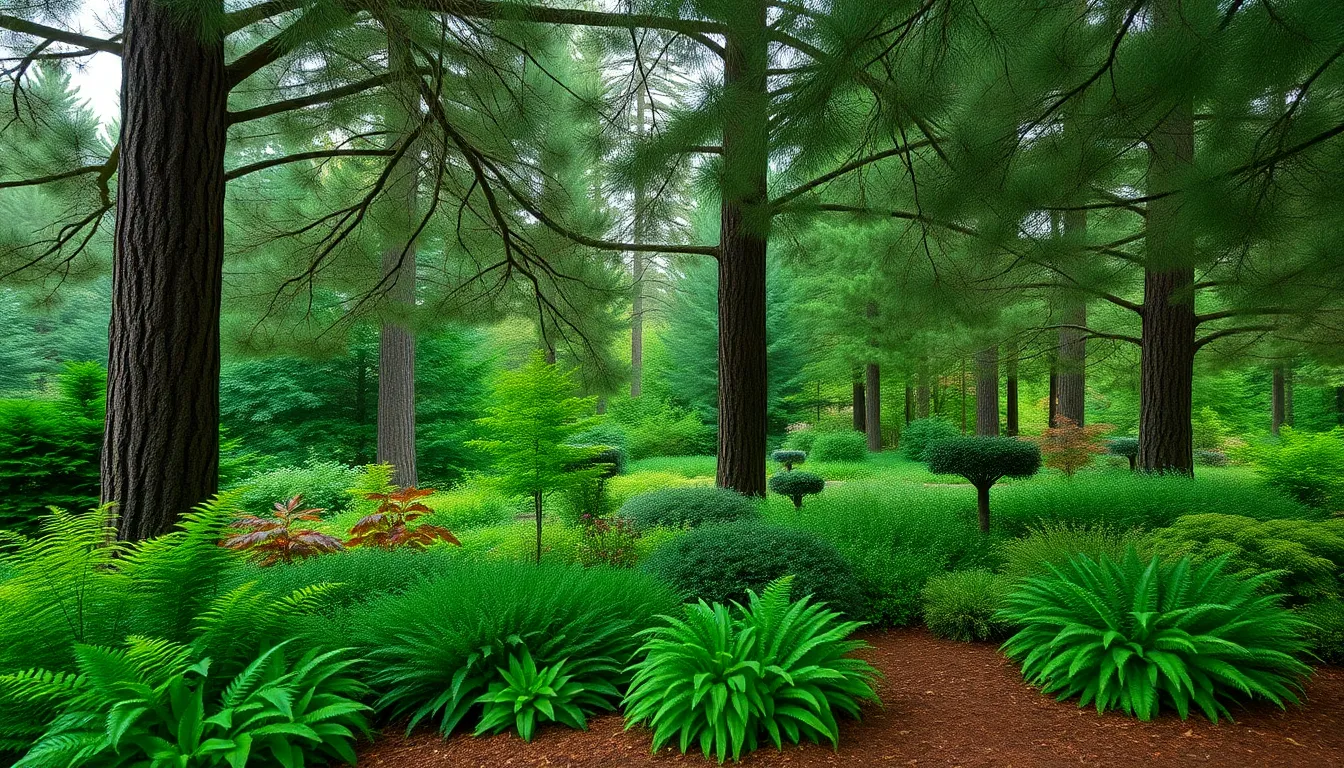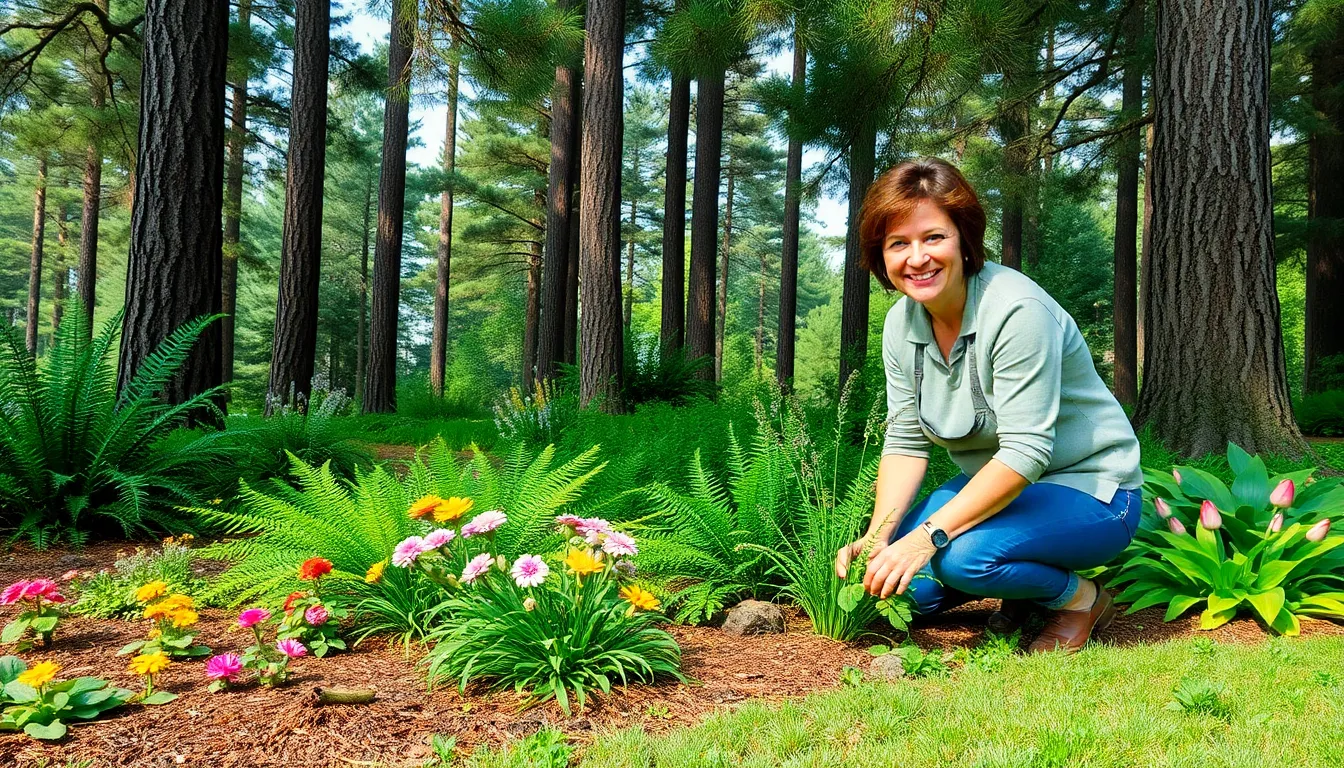Landscaping under pine trees can feel like a challenge worthy of a reality show. With those majestic giants casting shadows and dropping needles like confetti, it’s easy to think that your green thumb is doomed. But fear not! This unique environment can be transformed into a stunning oasis that even the most skeptical gardener would envy.
Landscaping Under Pine Trees
Landscaping under pine trees offers distinct advantages that enhance the garden’s appeal and functionality. These benefits include improved aesthetics and enhanced soil quality.
Improved Aesthetics
Creating visually appealing spaces becomes easier with the unique backdrop of pine trees. Dense foliage provides shade, enabling specific plants to thrive. Colorful flowers and textured foliage can flourish in contrasting areas, drawing the eye. Using ground covers like creeping thyme or ferns softens the area beneath trees. Incorporating decorative elements, such as rocks and mulch, enhances the overall design. Blending various plants creates a layered effect, which adds depth to the landscape.
Enhanced Soil Quality
Landscaping under pine trees often leads to improved soil conditions. Pine needles decompose, enriching the soil with organic material. This organic matter increases water retention, supporting plant health. Microbes thrive in the rich environment created by decomposing needles. Nutrient content rises, making it easier for surrounding plants to absorb essential elements. Additionally, soil acidity may increase slightly, benefiting acid-loving plants such as azaleas and rhododendrons. Designing careful layers promotes healthy growth while taking advantage of these favorable soil conditions.
Challenges Of Landscaping Under Pine Trees

Landscaping under pine trees poses specific challenges, primarily due to soil conditions and sunlight availability. Understanding these factors is essential for successful garden design.
Acidic Soil Conditions
Acidic soil conditions arise from the accumulation of pine needles and organic matter. This environment suits acid-loving plants like azaleas and rhododendrons. While these plants thrive, other species struggle to establish themselves. Soil amendments may prove useful in balancing pH levels, promoting healthier plant growth. Regular mulching with compost can enhance nutrient content and support the ecosystem. Designers can strategize by selecting plant varieties that flourish in acidic soil, ensuring a vibrant garden.
Limited Sunlight
Limited sunlight creates a challenging backdrop for many plants under pine trees. Pine canopies filter sunlight, making conditions suitable for only the hardiest species. Shade-tolerant plants like ferns and hostas thrive in such environments, adding texture and depth to the landscape. Proper plant placement becomes crucial to maximizing available light. Gardeners should consider layering plants, allowing taller species to provide necessary shade while shorter ones receive optimal sunlight. Carefully selecting plants adapted to shaded areas ensures a thriving garden despite limited light exposure.
Best Plants For Landscaping Under Pine Trees
Landscaping under pine trees requires careful selection of plants that thrive in low light and acidic soil. Various options exist that bring beauty and resilience.
Shade-Tolerant Plants
Ferns, such as lady ferns and maidenhair ferns, flourish in shaded areas. Hostas offer vibrant foliage and come in various colors, making them suitable for diverse designs. Astilbes add feathery flowers, enhancing vertical interest throughout the season. Heucheras, commonly known as coral bells, exhibit colorful leaves that contrast beautifully with pine needles. Shade-tolerant plants like these attract pollinators while complementing the natural beauty of pine environments.
Ground Covers
Creeping thyme spreads quickly across the ground, bringing fragrance and color. Other options include wintergreen, which provides evergreen foliage, and periwinkle, known for its vibrant blooms. These plants help suppress weeds and maintain moisture in the soil, promoting a healthier landscape. Additionally, native ground covers like wild ginger offer low maintenance, adapting well to the unique conditions under pine trees. Choices in ground covers can define the garden’s character and nurture the ecosystem.
Tips For Successful Landscaping Under Pine Trees
Creating a thriving garden under pine trees involves strategic planning and careful maintenance. By focusing on soil preparation and consistent care, gardeners can embrace the unique challenges this environment presents.
Soil Preparation Techniques
Soil quality plays a crucial role in plant health. Start by testing the pH level of the soil, which often becomes acidic due to needle accumulation. Amend the soil with lime to help neutralize acidity, promoting better growth for a wider range of plants. Adding organic matter, such as well-decomposed compost, improves structure and drainage, encouraging root development. Incorporate mulch around plants to retain moisture and minimize weed competition. Cultivating the soil to a depth of 12 inches ensures it remains loose and aerated, promoting healthy root systems.
Watering And Maintenance
Watering practices must adapt to the specific needs of plants under pine trees. Early morning is the best time for watering, ensuring foliage dries throughout the day and reducing disease risk. Maintain consistent soil moisture, particularly during dry spells, to support root growth. Regularly check for fallen pine needles and remove them, as they can create a thick layer that prevents moisture absorption. Fertilize plants with a balanced, slow-release formula every spring to provide essential nutrients. Monitoring for pests and diseases is crucial; prompt action can safeguard the health of the landscape.
Conclusion
Landscaping under pine trees presents unique challenges but also offers incredible opportunities for creativity. By choosing the right plants and employing effective soil management techniques, gardeners can turn these shaded areas into stunning retreats. The interplay of light and texture can create a serene environment that thrives despite the conditions. With careful planning and maintenance, these spaces can flourish, showcasing the beauty of shade-loving plants and vibrant ground covers. Embracing the potential of landscaping under pine trees can lead to a rewarding gardening experience that enhances both the landscape and the overall enjoyment of the outdoor space.

